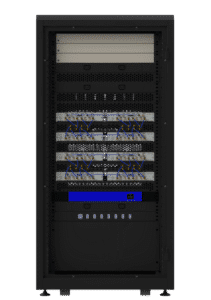GSG-Anechoic
ANECHOIC CHAMBER SIMULATOR SYSTEM
GSG-Anechoic GNSS Simulator allows users to accurately simulate real-world GNSS environments in their Anechoic Chambers. The GSG-Anechoic has up to 21 individual RF outputs enabling the system to drive up to 21 multi-frequency antennas. Revolutionary features like automatic antenna mapping, automatic time delay calibration, and automatic power loss calibration are what make GSG-Anechoic the most advanced anechoic chamber simulator on the market today.
Powered by the Skydel simulation engine, it features an easy to use software environment and an intuitive hardware build that supports engineers during all phases of their testing. The system can be calibrated in time and power — not only in relative terms (each antenna compared to the next), but also in absolute terms. The GSG-Anechoic system cuts calibration times from days to minutes. All aspects of the GSG-Anechoic system were made to enable better, faster, and lower cost testing.
Advantages
Automatic Antenna Mapping
Signals are automatically mapped to the correct transmit chain based on user specified antenna locations.
Automatic Power Loss Calibration
Automatically calibrates the power loss of each transmit chain.
Automatic Time Delay Calibration
Automatically calibrates the time delay of each transmit chain.
Scalable Software-Defined Architecture
GSG-Anechoic takes advantage of state-of-the-art software defined radios (SDR) for RF up-converting while signal IQ generation uses high performance commercial-off-the-shelf (COTS) graphics-processing units (GPU).
USE CASES
-
MNSA M-Code Testing in Defense Applications
Field testing GPS receivers to determine their performance and vulnerabilities in degraded or competing environments is standard practice.
LEARN MORE
-
GNSS Simulation: How Do I Choose A GPS/GNSS Simulator?
GNSS Simulators enable you to test a GPS or GNSS receiver device to ensure it will perform according to your requirements. This article provides considerations to select a GNSS Simulator.
-
An Engineer’s Guide to CRPA Testing
The applications and use cases for Controlled Reception Pattern Antennas (CRPAs), how they work, and the methods for testing them.
-
Software-Defined Architecture: Modern GNSS Simulation
Today, a disruptive innovation called software-defined architecture is rapidly displacing traditional bespoke architecture. This blog tells you why.
REQUEST A QUOTE
FEATURES
- Automatic antenna mapping
- Automatic time delay calibration
- Automatic power loss calibration
- 1000Hz Simulation Rate
- Spoofing Simulation
- Jamming Simulation
- Scalable architecture using COTS products
- IQ file generation and playback
SPECS
- RF Outputs/Signals:
- GPS Open Codes: L1-C/A, L1C, L1-P, L2-P, L2C, L5;
- Galileo: E1, E5a, E5b, E6 HAS
- BeiDou: B1, B2
- GLONASS: G1, G2;
- NavIC;
- QZSS;
- SBAS: L1, L5
- Custom Signals
- 16 bit IQ



